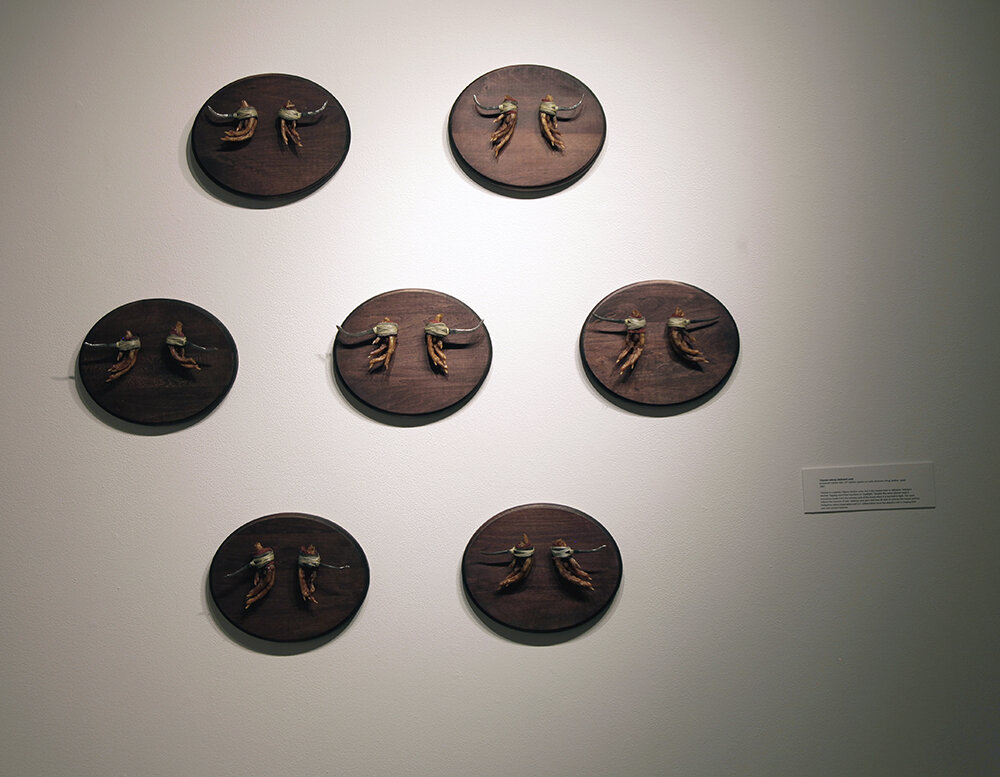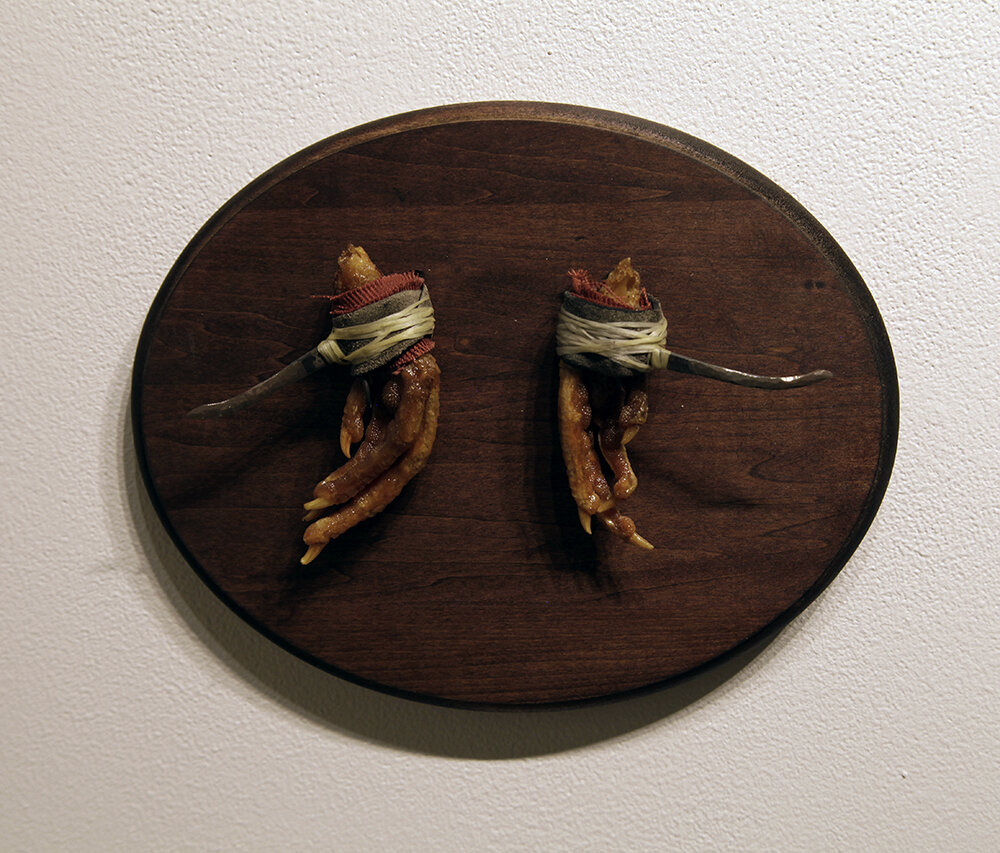Duty-Free Paradise
Radial Gallery | University of Dayton, Ohio
January 21 - February 25, 2021
2021
Duty-Free Paradise, a multimedia exhibition and live performance series that plays on the tensions of lived and imagined Hawai’i. Through the lens of eco-tourism, around which the islands’ economy heavily circulates. This work explores the contradictions between perceptions and realities of island life as a constructed paradise through American pop culture, down to the flora and fauna, underwritten by militarism and biopolitics. The exhibition Duty-Free Paradise first opened during the peak of the COVID-19 pandemic on January 21, 2021, coincidentally 15 days after the attempted coup on the U.S. Capitol Building, and four days after the anniversary of the coup of 1893 that overthrew Hawaiian sovereignty. It was because of Queen Lili'uokalani cooperation that it was considered to be a bloodless war - BLOODLESS Series (2018).
79 Visitors
79 red & white plastic leis
Wall text: Please take a lei as you enter the exhibition. Mahalo nui
2021
In September 2020 during the peak of the COVID-19 pandemic, 79 visitors arrived from Japan compared to 143,928 visitors in 2019. Year-to-date through September, Japanese arrivals declined 74.9 percent to 294,647 visitors. There were 6,033 U.S. East visitors In September, the majority were from the South Atlantic (-94.6% to 1,860), West South Central (-95.3% to 1,290) and East North Central (-96.5% to 860) regions. - Hawaii Tourism Authority: Hawaii Visitor Statistics Released for September 2020.
Golden Token: Bango 720740
360 video, print
2021
The video is a first-person exploration of the Dole Plantation Pineapple Garden Maze. The Dole Plantation’s website boasts that it has a 2.5-mile botanical maze composed of 14,000 Hawaiian plants and was the world’s largest maze as of 2008. The plantation is located near Whitmore Village in Wahiawa, where Asuncion’s family lives. The land in this district has been controlled by the U.S. military since 1888; and in 1941, the Naval Computer and Telecommunications Area Master Station Pacific (NCTAMS PAC) was moved there. The station at Wahiawa is located on approximately 700 acres of land in central Oahu on the eastern side of the highest part of the Schofield military base. The golden token in the video is an old stock of a 1959 coin commemorating the United States annexing Hawai’i as the 50th State of the U.S. The station at Wahiawa is located on approximately 700 acres of land in central Oahu on the eastern side of the highest part of the Schofield Plateau.’[ii] The wall print has been edited to leave only the phrase “Secret Stations,” echoing the histories of the land the Garden Maze’s grounds are located on.
The number 720740 is the number of the ticket Asuncion received the day they toured the garden maze, and bango is the Japanese word for number. On the plantations bangos were usually worn on a chain around plantation laborers necks, and the shape was typically determined by the worker's race. Every Hawaiian plantation used the bango system, which was borrowed from the slave tag system used in the South before the American Civil War. Laborers were required to wear their bango during working hours, and plantation accounts were kept by bango number rather than the employee’s name.
[i] “Naval Computer and Telecommunications Area Master Station Pacific,” Wikipedia, accessed August 26, 2021.
[ii] “The History of Wahiawa” Cryptology Information Warfare, accessed, August 27, 2021
The gold token in the video was produced by the United States to commemorate Hawaiʻi’s statehood in 1959. One side has the Great Seal of the State of Hawaiʻi and the other side depicts the United States of America Seal, while the entire coin was packaged with a survey of flora and fauna found in the islands.
HEX 424832
video still from virtual remote performance hosted by Blue House Arts at Front Street Gallery on Friday, February 05, 2021 @ 7-8 pm, 2021
This video still is from the interactive background used in HEX 424832, a virtual performance hosted by Blue House Arts at Front Street Gallery in Dayton, Ohio, that took place on Friday, February 5, 2021. A “hex” can be a spell, a curse, or a prefix for color numbers in the hexadecimal color-coding system, a tool for identifying exact colors across other systems including RGB, HSL, HSV, CMYK, and PANTONE. The color identified as hex #424832 is the same color as PANTONE 19-0419 TPX - Rifle Green. The ‘Rifle’ refers to the Honolulu Rifles, an armed militia that participated in the overthrow of 1893. The performance points to the deeply layered yet invisible way militarism is embedded in economic and political planning in Hawai`i and the influences it has on everyday life. A total of 11 military bases are in O`ahu, Maui, Kaua`i, and the Big Island, many of which were active in WWII.
Remote performance of Duty-Free Paradise hosted by Blue House Arts at Front Street Gallery that was on Friday, January 05, 2021 @ 7-8 PM. Documentation here.
The Local
7 year petrified pineapple, wood
2015-2022
In this piece, a fresh pineapple custom crated by Asuncion six years ago represents the last pineapple plantation in 2007 in Hawai`i, and canneries that eventually closed, the last one on Maui in 2017. They then moved overseas to the Philippines and Puerto Rico. This piece stands as a symbol of the last pineapple crop marking the end of 146 years of the production of this fruit as a monocrop in Hawai’i.
Fair Use Hawaii
Liteboxer, palm plants, paint, foam gym mats, 3-channel video
HD video | 11:26 trt
2021
This work critiques tourist activity during the COVID-19 pandemic, and the commodification of Hawaiʻi as an escape to paradise for those living overseas on the U.S. “mainland.” The video addresses the ways advertising media for eco-tourism continues neoliberal economic and political gain through the exploitation of Hawai’i resources, land, and peoples. The performative action of boxing reflects the cultural importance of boxing in Hawai’i since the 1920’s, and Asuncion’s training at Waipahu Boxing Club from 1995-97. It also reflects the struggle for a sense of identity and independence. The video uses transmedia storytelling by forcing the viewer to consider the backdrop of U.S. tourism in relation to the cultural violence and oppressions over the past two centuries.
Aloha Oe Song List | Song/ Artist
Aloha-Oe, Until We Meet Again by Goombay Dance Band
Hi’ilawe – Aloha ‘Oe by Gabby Pahinui (1972)
Aloha Oe by Elvis Presley
Aloha Oe (Acapella) by Tavita Te’o
Aloha Oe – The Kawaiahao Church Choir (1970)
In certain sections of the video, the figure is blurry while the background is in focus, and this shift in perspective is intentional. Asuncion shifts the viewer’s gaze from the foreground to the chrome key background, challenging the optic to see what is far away as blurry and what is in the foreground as in focus. Fair Use Hawaii flips this optical trope adopted by the cinematic tradition to create the illusion of clarity and a sense of control by the artist. It also subverts the gaze of the viewer away from the “exorcized” body on the screen and onto the idealized background, in the opposite way advertisements by Hawaii Pineapple Company (now Dole Food Company) from 1929-33 attempted to use the brown female body as source of advertisement and allure to market their pineapples.
Talunan sabong (defeated cock)
preserved rooster feet, 19th century square cut nails, beeswax string, leather, wood
2007-2022
Talunan is a popular Filipino chicken soup, but it also means loser or defeated. Sabong is another Tagalog word that translates to ‘cockfight.’ Despite the name talunan soup is sometimes made from the winning cock of the brood when it is too old to fight. This work reflects the nuances of war, violence, and sport and how all exist in cultures like Hawaii and the Philippines where Imperialism and U.S. militarization force has played a role in shaping their past and current histories.
In place where she stood
pineapple printed slippas, dirt
2020
This work was influenced by a letter Queen “Lydia” Lili`uokalani wrote while imprisoned at Iolani Palace following the overthrow of the Hawaiian monarchy by a Euro-American oligarchy that desired greater control of the Hawaiian government on January 17, 1893. The United States annexed the Republic of Hawai`i in 1898 during the presidency of William McKinley. Pineapples are printed on the pink slippers or ‘slippas’ as called in Hawaiian pidgin, to reference the Queen Lili’uokalani and the stand she took against her overthrow through letters of protest. The text is written in dirt or ʻĀina, the Hawaiian word meaning ‘land.’
ʻĀina text:
Alas! My love for my homeland and my beloved people. The bones of my bones the blood of my blood. Aloha! Aloha! Aloha!
Project made possible by the 2020 Live Arts Boston grant from the Boston Foundation & Blue House Arts in collaboration with Front Street Art supported by a Culture Works public arts grant.
Duty-Free Paradise, Special Issue - Art and Environment in Oceania, Pacific Arts, Volume 20, Issue 1. Pacific Arts Association, UC Santa Cruz, CA













